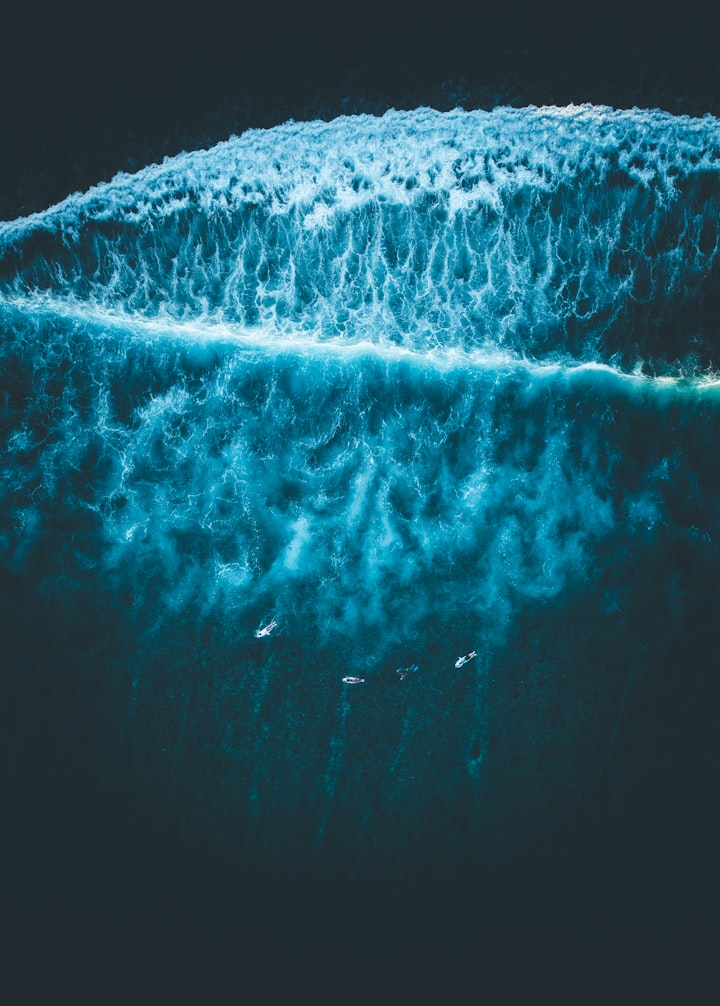In the event of a 50-meter high tsunami, should we run inland or plunge headlong into the water?
The manic side of the ocean

For people who don't go to the sea often or don't live by the sea, usually don't think the ocean will be too much of a problem.
Because in most people's impression, the ocean is often associated with a pleasant and relaxing life.
But without a careful understanding of the marine environment and climate in your local sea area, you are likely to look overwhelmed when faced with a bad marine disaster.
The worst thing that can happen to the ocean is a tsunami.
Even today, humans facing tsunamis are no different from people hundreds of years ago.
Once a tsunami occurs, there is only escape, there is no opportunity to fight it.
A small wave can knock down an adult and sweep him into the sea.
In the case of a tsunami, the power of the water will be magnified hundreds of times in the movement of the sea.
The displacement of a large amount of water causes a series of waves in the water column.
But it can also come from volcanic activity under the ocean, or seismic activity.
But unlike normal waves, which are usually generated by water displacement from large events, tsunamis are mostly generated because of tidal action.
Tsunamis usually consist of a series of waves with periods ranging from a few minutes to several hours, in physical manifestation as short bursts or envelopes of local wave action formed by a single unit propagating in a wave packet.
In some large events, tsunamis can produce wave heights of tens of meters.
It is so destructive that it can affect the entire ocean basin. Especially on the Indian Ocean coast, tsunamis are the worst natural disaster there.
The earliest superficial knowledge of tsunamis was gained in the history of the Peloponnesian War in ancient Greece.
But in the 20th century, human knowledge of tsunamis is still very little and there are many unknowns in it.
The main current research lies in why some large earthquakes do not produce tsunamis, while relatively small earthquakes do.
Japan may have had the largest number of recorded tsunamis in the last few decades, but not many have caused significant damage.
However, the 2004 Indian Ocean earthquake and tsunami, was the most devastating of the modern tsunami records, with 230,000 deaths.
There are also frequent tsunamis in the Sumatra region, with tsunamis of various sizes occurring along the island's coast.
And in the Mediterranean and parts of Europe, the threat of tsunamis is often underestimated.
Historical records of severe impacts include the Lisbon earthquake and tsunami of 1755, the Calabria earthquake of 1783, and the Messina earthquake and tsunami of 1908.
As mentioned earlier, tsunamis were recorded long ago in ancient Greece.
scholars at the time were the first to suggest that tsunamis were supposed to be caused by earthquakes, with the earliest records dating back to 479 BCE.
According to current research, the main mechanism of tsunamis lies in seawater displacement and ocean disturbance.
In general, water displacement is mostly caused by earthquakes, but can also be caused by landslides or volcanic eruptions.
Very few would be caused by nuclear tests or meteorite impacts, and there are various discussions about the possibility of tsunamis.
Mega-tsunamis
A mega-tsunami is a very rare type of ocean wave, and a 50-meter high tsunami is a special event and very destructive.o ordinary tsunamis occur mostly along plate boundaries because of underwater tectonic activity.
In the case of the strongest earthquakes, the height increases sharply as it approaches land, with a maximum rise of 30 meters.
Modern giant tsunamis include the 1883 Krakatoa eruption, and the 1958 Lituya Bay giant tsunami, which was caused by a landslide.
Before the 1950s, some scientists speculated that, in contrast, the giant tsunami could be the result of ancient geological processes.
However, at that time it was not possible to collect concrete evidence for the existence of these giant waves, and a study was presented in the 1999 Tsunami Society that analyzed the mechanism of the giant tsunami about the events in the Gulf of Lituya.
Although the earthquake that caused the tsunami was considered the most likely guiding factor for the mega-tsunami, it was not the only contributor based on the measured wave heights.
Lake drainage, landslides, and earthquakes by themselves are not powerful enough to cause observable mega-tsunamis.
n fact, mega-tsunamis are caused by a rapid sequence of events.
The main event occurs in the form of a huge and sudden impact when hundreds of meters and more than 40 million cubic meters of rock above Lituya Bay are destroyed by an earthquake.
The pile of rocks fell almost vertically into the bay as a single unit.
As the falling rocks also changed their internal viscosity, the mixture of rock and air increased the displacement of water, further affecting the sediments at the bottom of the bay.
Mega-tsunamis are often incredibly destructive, and extreme tsunamis are even more so.
The most famous Hixulub crater, although the meteorite at the time brought limited wave action in relatively shallow waters.
However, scientists deduced that if the asteroid had hit the deep sea, it would have brought about a tsunami height of 4.6 km.
In the mechanism of triggering a giant tsunami, the direct impact, shock waves, and backflow water in the crater including outward thrust can cause extremely strong magnitude.
Scientists' latest simulation of the global impact of a giant tsunami reached an initial wave height of 1.5 kilometers and subsequently brought waves of up to 100 meters in the Gulf of Mexico. Such a devastating disaster was inevitable at the time.
The tsunami waves were compressed near the coast, and the shortening of the wavelength would direct the wave energy upward, thus greatly increasing their height.
The effect is like ordinary surfing, where the tsunami energy must be contained in a smaller volume of water, so the waves become higher.
Although the wavelength shortens near the coast, the wavelength usually exceeds 10 km when the tsunami comes ashore.
Also because of the different water depths and coastal configurations, the refraction and energy convergence of the waves may further increase the height.
Even though the tsunami wave in the deep ocean may be less than 1 meter, it may still trigger a giant wave of 30 to 35 meters when it comes to the coast.
After we understand some simple mechanisms of wave action and its possible causes, all that remains is safety precautions against tsunamis.
Although the likelihood of a mega-tsunami is low, there is still a relatively good warning for us to avoid damage when faced with a normal tsunami or indeed a mega-tsunami.
Once a tsunami occurs, the best option is to flee to the inland areas.
Through the previous introduction, we can see that the tsunami will "grow" rapidly with the help of various forces.
And become quite destructive, if this time also goes to the water, the waves can easily swallow a person into the ocean interior.
The coast is usually the most damaged area
Only when you move away from the coast, the less danger a tsunami poses.
In addition, tsunamis can travel up to 6 km inland, depending on the shape and slope of the coastline.
While staying away from the coast, choose highland areas as much as possible, because at this time the sea will flood most of the area.
If we do not have time to flee further inland at this point, then it is best to stay as far away from the coast as possible and flee to a sturdy and reliable high-rise building.
It is best to go up to a height of 3 or more stories or even higher.
What if the worst-case scenario is that we are now on the coast?
Generally speaking, there are corresponding tsunami escape routes near the coast, so complete the evacuation according to the planning specified in the escape route and look for tsunami evacuation towers.
If you can't reach any other type of high ground at this point, the last option is to climb a tall and sturdy tree.
If faced with the worst-case scenario, and has been swept away by the waves. The only thing that can ensure safety is something solid, such as a tree, a door panel, or a life raft.
Do not give up the possibility of survival in any situation, any solid object you can grab can be a chance to save your life.
What if you are unlucky enough to be on a boat when a tsunami occurs?
The approach at this point is different than on land. We should steer the boat out into the open ocean, facing the waves and heading as far away as possible.
If a tsunami warning has been issued for the area, it is even more important not to return to the harbor, which is therefore very dangerous at this time.
Tsunami activity can cause dangerous currents and current movements near the harbor shoreline, which can cause the ship to capsize.
Even if we have moved away from the tsunami, we should still not take it lightly and should stay in a safe location for at least 8 hours.
Tsunamis can take longer to move than we think, and waiting patiently for notification signals is the best option.
Of course, any disaster is a precautionary one, and escape means the situation has already happened.
Before a tsunami occurs, we can observe some unusual events.
For example, the ocean will have a loud roaring sound, which is the sound formed by the sea water being sucked into the ocean during the formation of a tsunami.
Generally speaking, giant tsunamis are often accompanied by strong earthquakes, and if the epicenter is far from the sea, people may not always be able to detect it.
Watch carefully for changes in the environment, such as the unusual activity of distant seabirds.
In the face of large natural disasters, humans can often seem powerless and there is not much we can do.
About the Creator
Richard Shurwood
If you wish to succeed, you should use persistence as your good friend, experience as your reference, prudence as your brother and hope as your sentry.






Comments
There are no comments for this story
Be the first to respond and start the conversation.